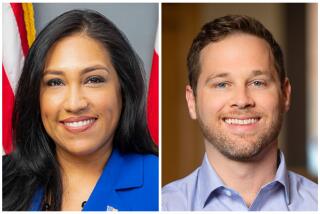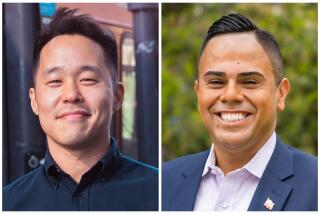Santa Clarita: They Stand United but Run Diversely
- Share via
Political newcomer Dennis M. Koontz rode in a bright-red antique fire engine with music from the movie “Rocky” blasting from a loudspeaker. Another political novice, Vernon H. Pera, handed out balloons from a convertible.
Seasoned campaigners H. G. (Gil) Callowhill, Carl Boyer III and Louis E. Brathwaite--whose names are more familiar to Santa Clarita Valley voters--used few gimmicks for attention. They rode together in an old Cadillac, simply waving at spectators at the recent Frontier Days parade in Canyon Country.
When it comes to cityhood issues, the 25 candidates seeking the five at-large seats on the proposed city of Santa Clarita’s first city council on Nov. 3 exhibit few differences. All want the area’s destiny to be controlled by elected residents instead of by the Los Angeles County Board of Supervisors, which they see as a remote entity.
But when it comes to campaigning, the candidates are distinctly individualistic, guided by their experience in politics and the amount of money in their treasuries. The 21 men and four women have a variety of campaigning styles that, by their sheer numbers, are commanding the attention of a community that never before has seen so many clamoring for so few seats.
The candidates are undaunted by the fact that they are seeking offices that don’t yet exist. Unless the more than 47,000 registered voters in the proposed 40-square-mile city approve incorporation, the winners never will be seated.
As Pera put it, “The county doesn’t care about us. Cityhood is an opportunity for Santa Clarita to become one of the most powerful cities in the state. It’s an opportunity to become more than that spot out by Magic Mountain.”
A Durable Idea
“The cityhood idea was good in 1962, and it’s good now,” said candidate Andy Martin, referring to the first of several times that Santa Clarita Valley residents have tried--and failed--to break away from Los Angeles County rule and govern themselves. “With local city council members, the neighbors can go out and throw rocks at them. But what can you do about the supervisors? You can’t even get to them.”
Candidate Michael D. Lyons said cityhood will provide residents with “real representative government, not just diluted county democracy.”
To that end, almost all the candidates have attended fund-raisers and workshops sponsored by the City of Santa Clarita Formation Committee and have appeared on the same platform at three public candidates’ forums. By Nov. 3, they will have spoken at three other forums, participated in a candidates’ fair and twice helped city formation committee volunteers hand out pro-cityhood literature at shopping centers.
Because they often appear as a group, the candidates, especially those who are unknown to voters, must use their ingenuity to capture voters’ attention.
“We have a variety of candidates who have a variety of experience,” said Connie Worden, city formation committee spokeswoman. “Those who have been elected to previous offices tend to be more low-key. The less experienced ones have to be more creative and assertive.”
Koontz, for example, is quick to make his presence known wherever voters are present, Worden observed. “He introduces himself everywhere.”
Linda Hovis Storli, another newcomer to politics, announced two weeks ago that, if elected, she would resign from her job as a government teacher at Canyon High School. That decision “did not come easily,” she said. “I hope this shows I’m very sincere.”
$600 Per Month
Members of the city council will receive $600 per month, an amount set by state law.
Storli is conducting a high-energy campaign on a shoestring. She said she is “speaking to every single group that will have me and talking to as many people as I can.” She also is handing out flyers door-to-door.
Maurice D. Ungar, another political unknown, and his wife, Kathy, are going it alone. Ungar’s campaign committee is “just the two of us,” his wife said. She designed his flyers and hands them out at candidates’ forums and other events.
Ungar is not accepting campaign donations--even small ones--because he said he does not want to be obligated to anyone. “The money for my campaign is coming out of my own pocket,” he said.
Most candidates are hoping a mass mailing to voters and public appearances will get their message across. Several, like Storli and Ungar, are walking door-to-door. Some, including Jo Anne Darcy, Ungar, Bill Hilton, Roger A. Meurer, Pera and Janice Heidt, have paid an average of $500 apiece for 6-by-12-foot billboards at strategic locations.
Only a few of the candidates have the name recognition necessary to get elected without too much campaigning. Boyer, Brathwaite, Callowhill, William J. Broyles, Howard P. (Buck) McKeon and Robert Silverstein previously have been elected to local offices in the Santa Clarita Valley.
Callowhill, in his fourth term on the Castaic Lake Water Agency board, said he believes he has name recognition and will spend little money campaigning.
“I doubt I’ve spent $35 altogether in all of my campaigns,” said Callowhill, who also was elected supervisor during the Santa Clarita Valley’s unsuccessful attempt to form its own county in 1978. “I’ll knock on some doors.”
McKeon, president of the William S. Hart High School District board, also has announced he will resign from that office if elected to the city council.
Among the other candidates, Kenneth Dean and Martin also have been active in political circles. Heidt is noted for her activist stands on planning matters before the Board of Supervisors.
Cooperative Campaigns
Heidt and her husband, Gerald, who is running for reelection to the Hart high school district board, both have bought space on billboards.
“His billboard gives her double exposure,” said one political observer. “That’s very smart.”
“I have put up one sign,” Heidt said. “But my campaign is to the people. Just ordinary people are working on my campaign. We’re going door-to-door.”
Lyons and Gail Klein are counting on their involvement with the Santa Clarita Valley Planning Advisory Committee to help them get elected. Lyons emphasizes his role in helping draft the county’s proposed ordinance restricting the cutting down of oak trees to accommodate development.
Hard Campaigning
Hilton, a minister, and Richard Vacar, manager of airport affairs at Burbank Airport, are campaigning hard, making frequent public appearances. They have the ability to “become known,” said a local political observer. Dean and Meurer also are hard-working candidates, the observer said.
As Supervisor Mike Antonovich’s field representative, Darcy is probably the best known candidate and, some say, the most vulnerable. Although no candidate has as yet openly attacked Darcy, several have said privately that her dual roles in the county and the city would constitute a conflict of interest. She has been criticized by residents in letters to the area’s local newspaper, the Newhall Signal, and by cityhood foe Anthony J. Skirlick Jr. of Citizens Against Cityhood.
“For Ms. Darcy to call into question the viability and efficiency of county government is to, in fact, indict herself, since she is a prominent official within that scheme of government,” Skirlick said.
Darcy denied she will have any conflict of interest serving as both Antonovich’s field deputy and as a city council member. Rather, she said, her experience will help the new city when dealing with the county.
“I can be a valuable asset to the city in maintaining open channels of communication and rapport with county government,” Darcy said. “I know how to cut red tape, reach the right people and analyze problems to find successful solutions and still maintain a compatible relationship with all governments.”
Legal Advice
She said attorneys have advised her that it is legal under state law for her to work for an elected official and be one herself as long as the two jobs are for separate government bodies.
“I can do both jobs, fairly, honestly and with the highest integrity,” Darcy said. She added that there might be rare occasions in lawsuits involving the county that she might have to abstain from voting.
Darcy also is the candidate with the most money. County Registrar-Recorder records show that as of Sept. 19, the most recent filing deadline for campaign-spending reports, she had $8,926 in her campaign treasury. The largest donation was $1,000 from a Pacific Palisades mobile-home park owner. Others were $500 or lower, with 33 donations of less than $100. State law requires that candidates report the sources of any contributions of $100 or more.
At a forum, answering a question about which candidates had received contributions from outside the Santa Clarita Valley, Darcy said that she had--from some “very dear friends I’ve known for years. That’s how I was able to put my billboards up.”
Koontz quipped that he had received $500 from his mother.
Vacar, with $7,032 in donations, is close behind Darcy. However, the major portion of Vacar’s donations was from a Los Angeles graphics firm, which contributed the printing of campaign brochures in a job worth $5,492.
Ungar said he had spent $2,000 from his own pocket.
Other candidates receiving more than $1,000 in donations were Storli at $1,487 and Heidt at $1,061.
Vow to Spend Under $500
Filing declarations that they would more spend no more than $500 on their entire campaign, which is allowable without filing reports, were Boyer, Callowhill, Jeffrey D. Christensen, Dennis Conn, Dean, Lyons, McKeon, Ronald J. Nolan, Frank A. Parkhurst, Pera and Edmund G. Stevens. Most of the others have vowed to accept only donations of $99 or less, which do not have to be reported.
Two candidates, Monty Harrell and Broyles, have done little to campaign. So far, Harrell has shown up at no candidates’ forums. Broyles appeared at his first forum last week. He is running for another seat on the same ballot--for Santa Clarita Community College District trustee, an office he has held before.
Nolan, who has spent most of his time up until last week studying for the State Bar examination, has just started his campaign.
Conn tells voters to ask him about cityhood, not about himself. “I’m not half as qualified as most of these people up here,” he said at a recent candidates’ forum.
On the ballot in addition to the city council candidates and Proposition U, the cityhood measure, is Proposition V. That measure asks voters to decide, if cityhood is approved, whether they want to elect city council members by district or at large in future elections.
If cityhood is approved, the five candidates elected to the new Santa Clarita City Council will shape the futures of 110,000 people within the city’s borders. Santa Clarita, if it comes to be, will be Los Angeles County’s 85th city.
More to Read
Sign up for Essential California
The most important California stories and recommendations in your inbox every morning.
You may occasionally receive promotional content from the Los Angeles Times.













